MAJOR SKILLS FOR DARING LEADERSHIP STYLE
VerifiedAdded on 2022/08/17
|11
|2913
|18
AI Summary
Contribute Materials
Your contribution can guide someone’s learning journey. Share your
documents today.
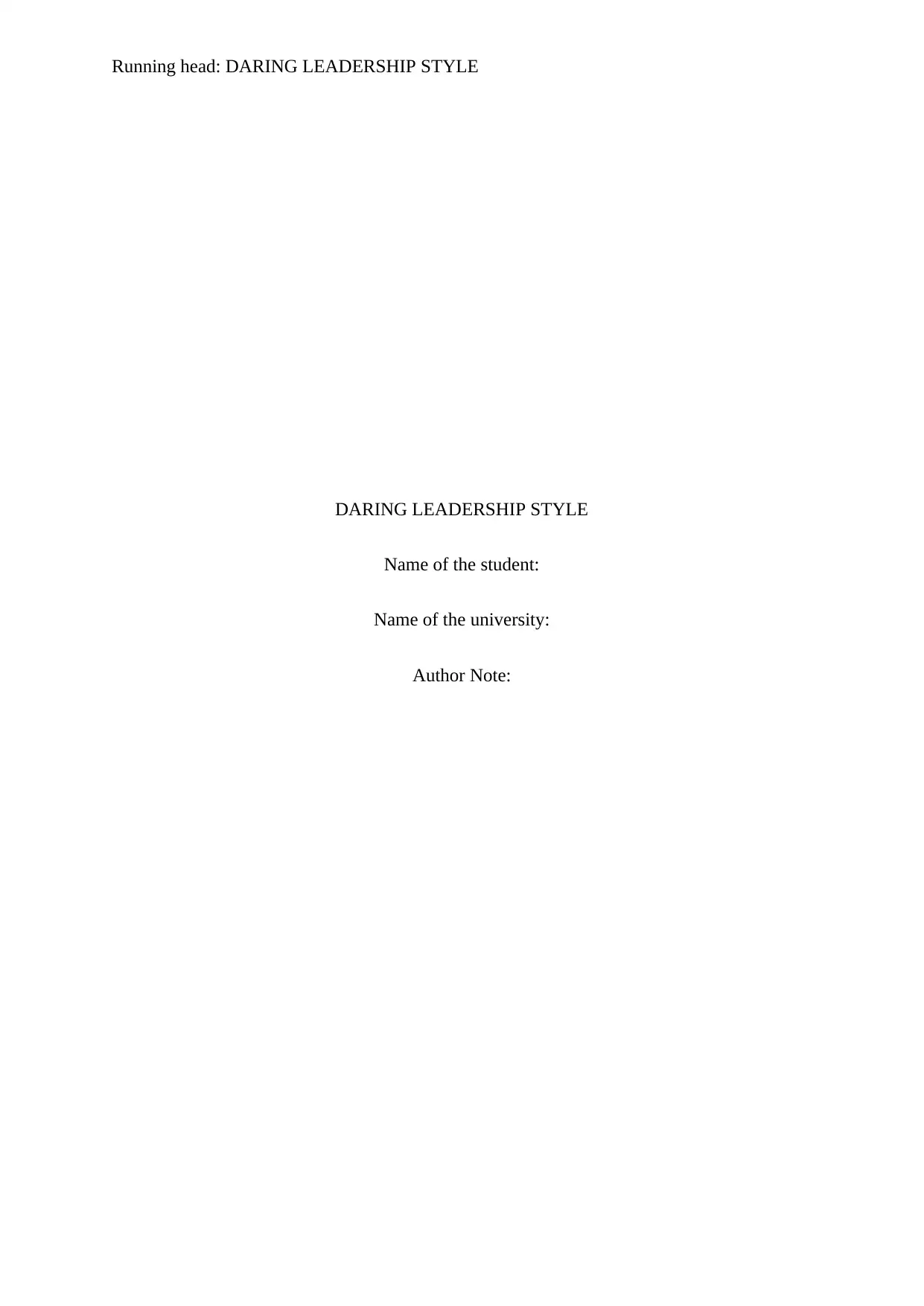
Running head: DARING LEADERSHIP STYLE
DARING LEADERSHIP STYLE
Name of the student:
Name of the university:
Author Note:
DARING LEADERSHIP STYLE
Name of the student:
Name of the university:
Author Note:
Secure Best Marks with AI Grader
Need help grading? Try our AI Grader for instant feedback on your assignments.
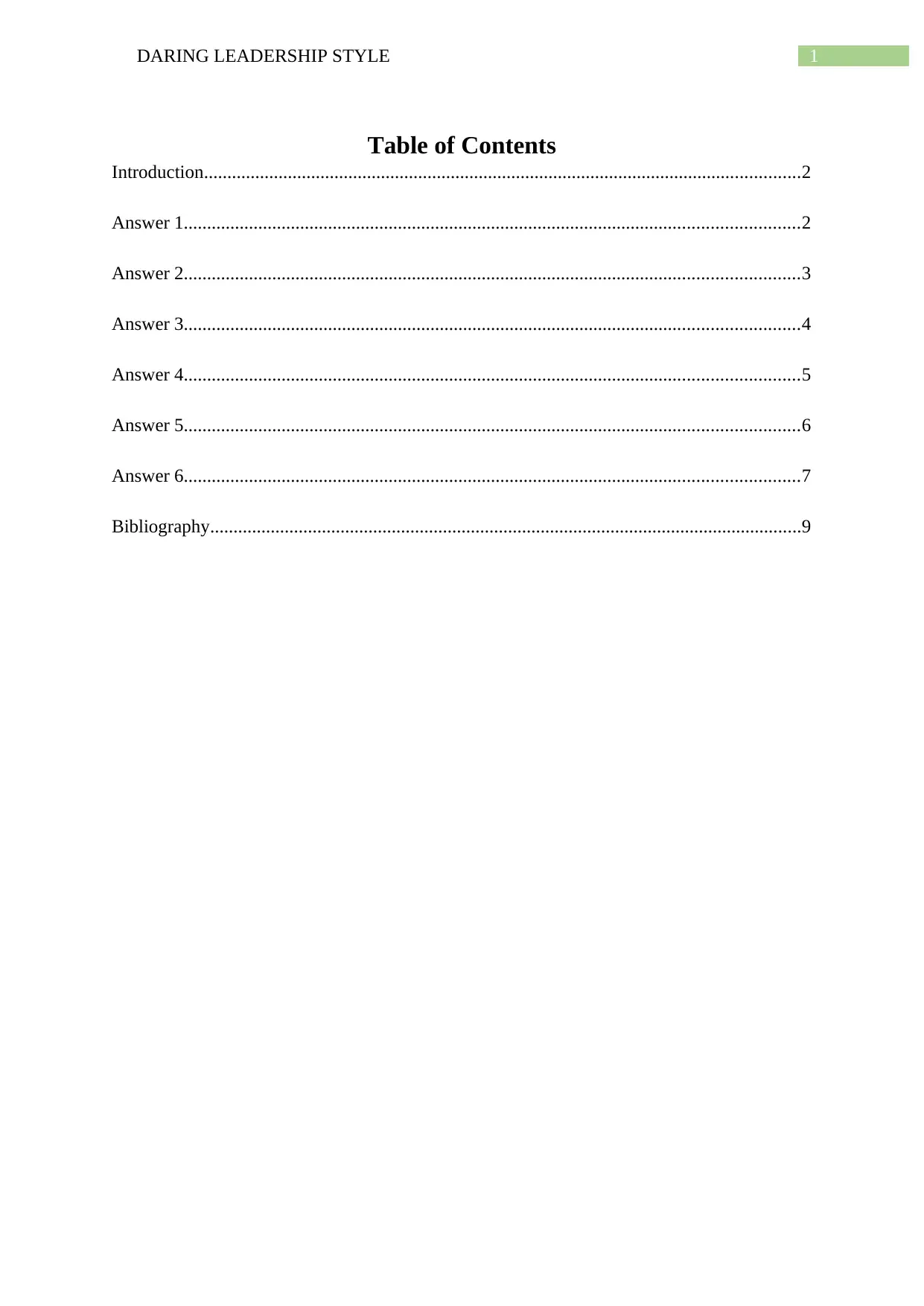
1DARING LEADERSHIP STYLE
Table of Contents
Introduction................................................................................................................................2
Answer 1....................................................................................................................................2
Answer 2....................................................................................................................................3
Answer 3....................................................................................................................................4
Answer 4....................................................................................................................................5
Answer 5....................................................................................................................................6
Answer 6....................................................................................................................................7
Bibliography...............................................................................................................................9
Table of Contents
Introduction................................................................................................................................2
Answer 1....................................................................................................................................2
Answer 2....................................................................................................................................3
Answer 3....................................................................................................................................4
Answer 4....................................................................................................................................5
Answer 5....................................................................................................................................6
Answer 6....................................................................................................................................7
Bibliography...............................................................................................................................9
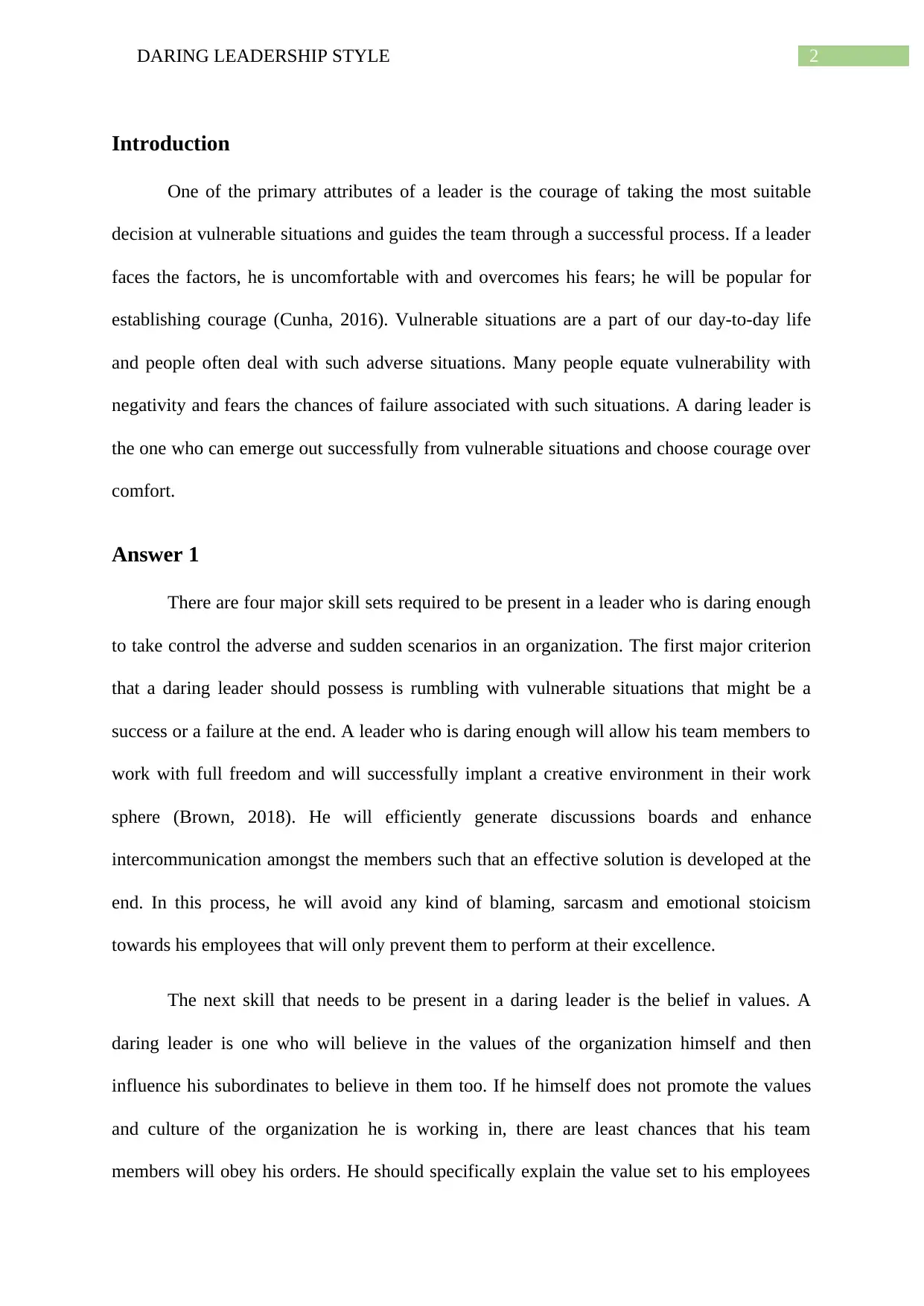
2DARING LEADERSHIP STYLE
Introduction
One of the primary attributes of a leader is the courage of taking the most suitable
decision at vulnerable situations and guides the team through a successful process. If a leader
faces the factors, he is uncomfortable with and overcomes his fears; he will be popular for
establishing courage (Cunha, 2016). Vulnerable situations are a part of our day-to-day life
and people often deal with such adverse situations. Many people equate vulnerability with
negativity and fears the chances of failure associated with such situations. A daring leader is
the one who can emerge out successfully from vulnerable situations and choose courage over
comfort.
Answer 1
There are four major skill sets required to be present in a leader who is daring enough
to take control the adverse and sudden scenarios in an organization. The first major criterion
that a daring leader should possess is rumbling with vulnerable situations that might be a
success or a failure at the end. A leader who is daring enough will allow his team members to
work with full freedom and will successfully implant a creative environment in their work
sphere (Brown, 2018). He will efficiently generate discussions boards and enhance
intercommunication amongst the members such that an effective solution is developed at the
end. In this process, he will avoid any kind of blaming, sarcasm and emotional stoicism
towards his employees that will only prevent them to perform at their excellence.
The next skill that needs to be present in a daring leader is the belief in values. A
daring leader is one who will believe in the values of the organization himself and then
influence his subordinates to believe in them too. If he himself does not promote the values
and culture of the organization he is working in, there are least chances that his team
members will obey his orders. He should specifically explain the value set to his employees
Introduction
One of the primary attributes of a leader is the courage of taking the most suitable
decision at vulnerable situations and guides the team through a successful process. If a leader
faces the factors, he is uncomfortable with and overcomes his fears; he will be popular for
establishing courage (Cunha, 2016). Vulnerable situations are a part of our day-to-day life
and people often deal with such adverse situations. Many people equate vulnerability with
negativity and fears the chances of failure associated with such situations. A daring leader is
the one who can emerge out successfully from vulnerable situations and choose courage over
comfort.
Answer 1
There are four major skill sets required to be present in a leader who is daring enough
to take control the adverse and sudden scenarios in an organization. The first major criterion
that a daring leader should possess is rumbling with vulnerable situations that might be a
success or a failure at the end. A leader who is daring enough will allow his team members to
work with full freedom and will successfully implant a creative environment in their work
sphere (Brown, 2018). He will efficiently generate discussions boards and enhance
intercommunication amongst the members such that an effective solution is developed at the
end. In this process, he will avoid any kind of blaming, sarcasm and emotional stoicism
towards his employees that will only prevent them to perform at their excellence.
The next skill that needs to be present in a daring leader is the belief in values. A
daring leader is one who will believe in the values of the organization himself and then
influence his subordinates to believe in them too. If he himself does not promote the values
and culture of the organization he is working in, there are least chances that his team
members will obey his orders. He should specifically explain the value set to his employees
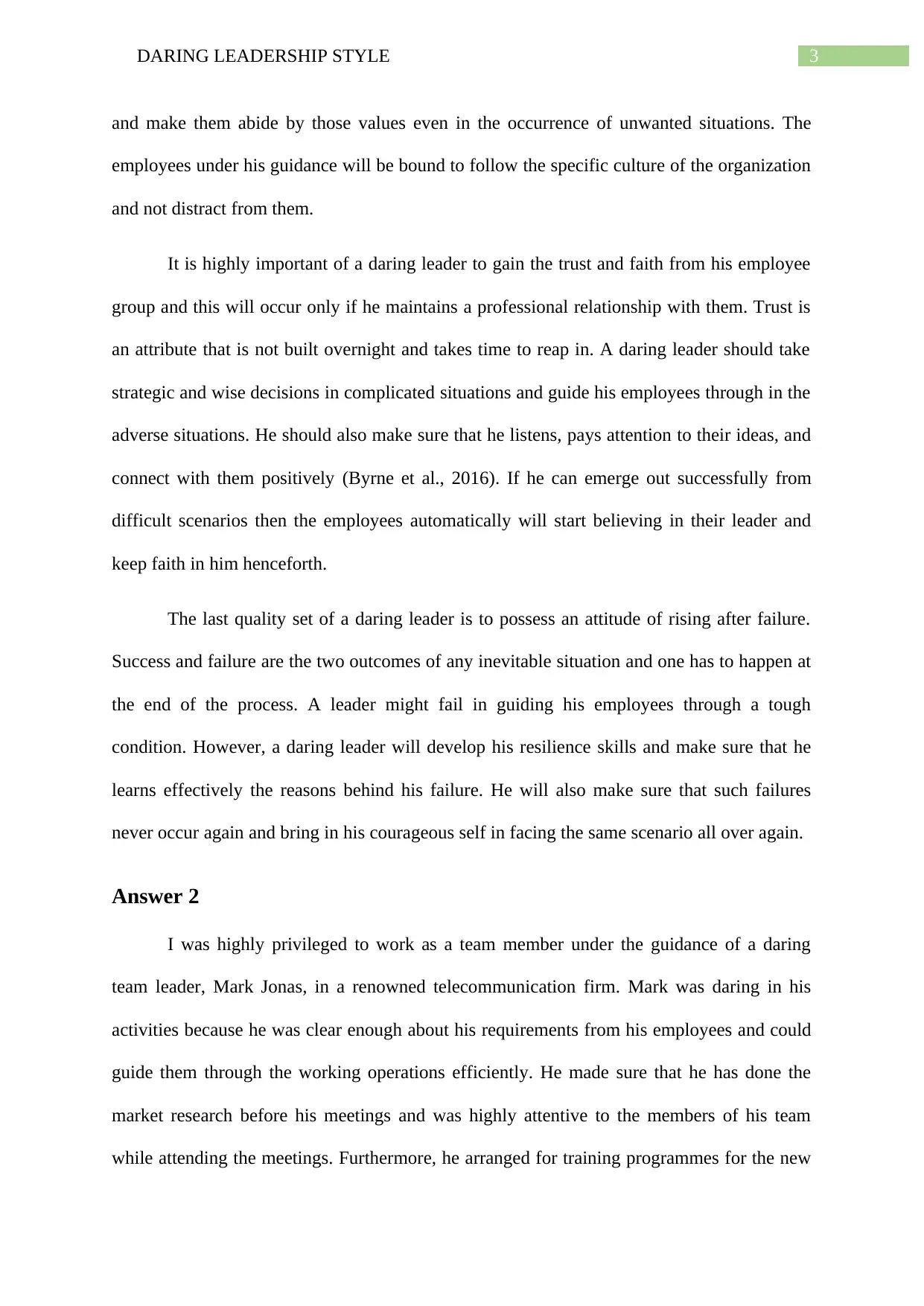
3DARING LEADERSHIP STYLE
and make them abide by those values even in the occurrence of unwanted situations. The
employees under his guidance will be bound to follow the specific culture of the organization
and not distract from them.
It is highly important of a daring leader to gain the trust and faith from his employee
group and this will occur only if he maintains a professional relationship with them. Trust is
an attribute that is not built overnight and takes time to reap in. A daring leader should take
strategic and wise decisions in complicated situations and guide his employees through in the
adverse situations. He should also make sure that he listens, pays attention to their ideas, and
connect with them positively (Byrne et al., 2016). If he can emerge out successfully from
difficult scenarios then the employees automatically will start believing in their leader and
keep faith in him henceforth.
The last quality set of a daring leader is to possess an attitude of rising after failure.
Success and failure are the two outcomes of any inevitable situation and one has to happen at
the end of the process. A leader might fail in guiding his employees through a tough
condition. However, a daring leader will develop his resilience skills and make sure that he
learns effectively the reasons behind his failure. He will also make sure that such failures
never occur again and bring in his courageous self in facing the same scenario all over again.
Answer 2
I was highly privileged to work as a team member under the guidance of a daring
team leader, Mark Jonas, in a renowned telecommunication firm. Mark was daring in his
activities because he was clear enough about his requirements from his employees and could
guide them through the working operations efficiently. He made sure that he has done the
market research before his meetings and was highly attentive to the members of his team
while attending the meetings. Furthermore, he arranged for training programmes for the new
and make them abide by those values even in the occurrence of unwanted situations. The
employees under his guidance will be bound to follow the specific culture of the organization
and not distract from them.
It is highly important of a daring leader to gain the trust and faith from his employee
group and this will occur only if he maintains a professional relationship with them. Trust is
an attribute that is not built overnight and takes time to reap in. A daring leader should take
strategic and wise decisions in complicated situations and guide his employees through in the
adverse situations. He should also make sure that he listens, pays attention to their ideas, and
connect with them positively (Byrne et al., 2016). If he can emerge out successfully from
difficult scenarios then the employees automatically will start believing in their leader and
keep faith in him henceforth.
The last quality set of a daring leader is to possess an attitude of rising after failure.
Success and failure are the two outcomes of any inevitable situation and one has to happen at
the end of the process. A leader might fail in guiding his employees through a tough
condition. However, a daring leader will develop his resilience skills and make sure that he
learns effectively the reasons behind his failure. He will also make sure that such failures
never occur again and bring in his courageous self in facing the same scenario all over again.
Answer 2
I was highly privileged to work as a team member under the guidance of a daring
team leader, Mark Jonas, in a renowned telecommunication firm. Mark was daring in his
activities because he was clear enough about his requirements from his employees and could
guide them through the working operations efficiently. He made sure that he has done the
market research before his meetings and was highly attentive to the members of his team
while attending the meetings. Furthermore, he arranged for training programmes for the new
Secure Best Marks with AI Grader
Need help grading? Try our AI Grader for instant feedback on your assignments.
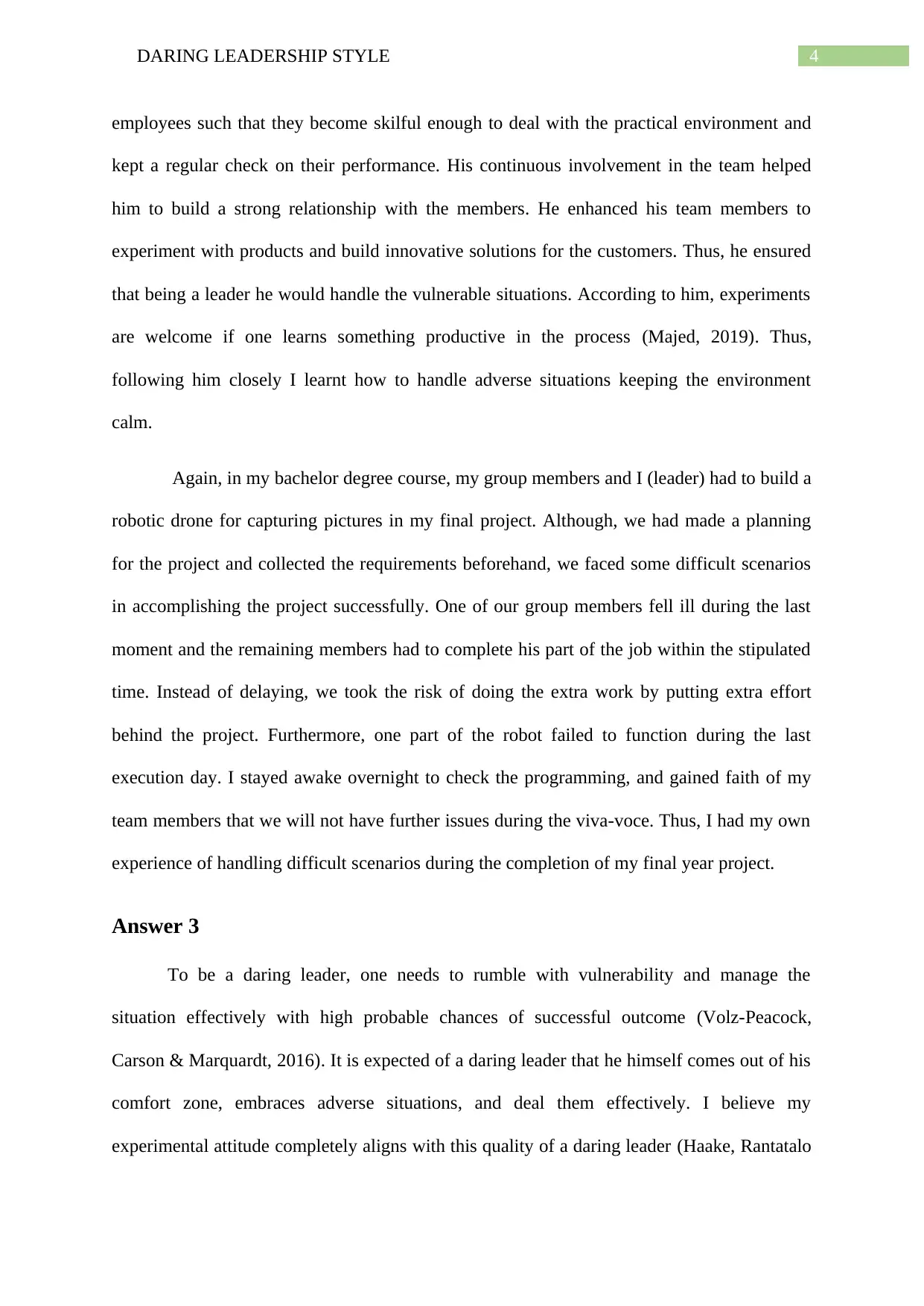
4DARING LEADERSHIP STYLE
employees such that they become skilful enough to deal with the practical environment and
kept a regular check on their performance. His continuous involvement in the team helped
him to build a strong relationship with the members. He enhanced his team members to
experiment with products and build innovative solutions for the customers. Thus, he ensured
that being a leader he would handle the vulnerable situations. According to him, experiments
are welcome if one learns something productive in the process (Majed, 2019). Thus,
following him closely I learnt how to handle adverse situations keeping the environment
calm.
Again, in my bachelor degree course, my group members and I (leader) had to build a
robotic drone for capturing pictures in my final project. Although, we had made a planning
for the project and collected the requirements beforehand, we faced some difficult scenarios
in accomplishing the project successfully. One of our group members fell ill during the last
moment and the remaining members had to complete his part of the job within the stipulated
time. Instead of delaying, we took the risk of doing the extra work by putting extra effort
behind the project. Furthermore, one part of the robot failed to function during the last
execution day. I stayed awake overnight to check the programming, and gained faith of my
team members that we will not have further issues during the viva-voce. Thus, I had my own
experience of handling difficult scenarios during the completion of my final year project.
Answer 3
To be a daring leader, one needs to rumble with vulnerability and manage the
situation effectively with high probable chances of successful outcome (Volz-Peacock,
Carson & Marquardt, 2016). It is expected of a daring leader that he himself comes out of his
comfort zone, embraces adverse situations, and deal them effectively. I believe my
experimental attitude completely aligns with this quality of a daring leader (Haake, Rantatalo
employees such that they become skilful enough to deal with the practical environment and
kept a regular check on their performance. His continuous involvement in the team helped
him to build a strong relationship with the members. He enhanced his team members to
experiment with products and build innovative solutions for the customers. Thus, he ensured
that being a leader he would handle the vulnerable situations. According to him, experiments
are welcome if one learns something productive in the process (Majed, 2019). Thus,
following him closely I learnt how to handle adverse situations keeping the environment
calm.
Again, in my bachelor degree course, my group members and I (leader) had to build a
robotic drone for capturing pictures in my final project. Although, we had made a planning
for the project and collected the requirements beforehand, we faced some difficult scenarios
in accomplishing the project successfully. One of our group members fell ill during the last
moment and the remaining members had to complete his part of the job within the stipulated
time. Instead of delaying, we took the risk of doing the extra work by putting extra effort
behind the project. Furthermore, one part of the robot failed to function during the last
execution day. I stayed awake overnight to check the programming, and gained faith of my
team members that we will not have further issues during the viva-voce. Thus, I had my own
experience of handling difficult scenarios during the completion of my final year project.
Answer 3
To be a daring leader, one needs to rumble with vulnerability and manage the
situation effectively with high probable chances of successful outcome (Volz-Peacock,
Carson & Marquardt, 2016). It is expected of a daring leader that he himself comes out of his
comfort zone, embraces adverse situations, and deal them effectively. I believe my
experimental attitude completely aligns with this quality of a daring leader (Haake, Rantatalo
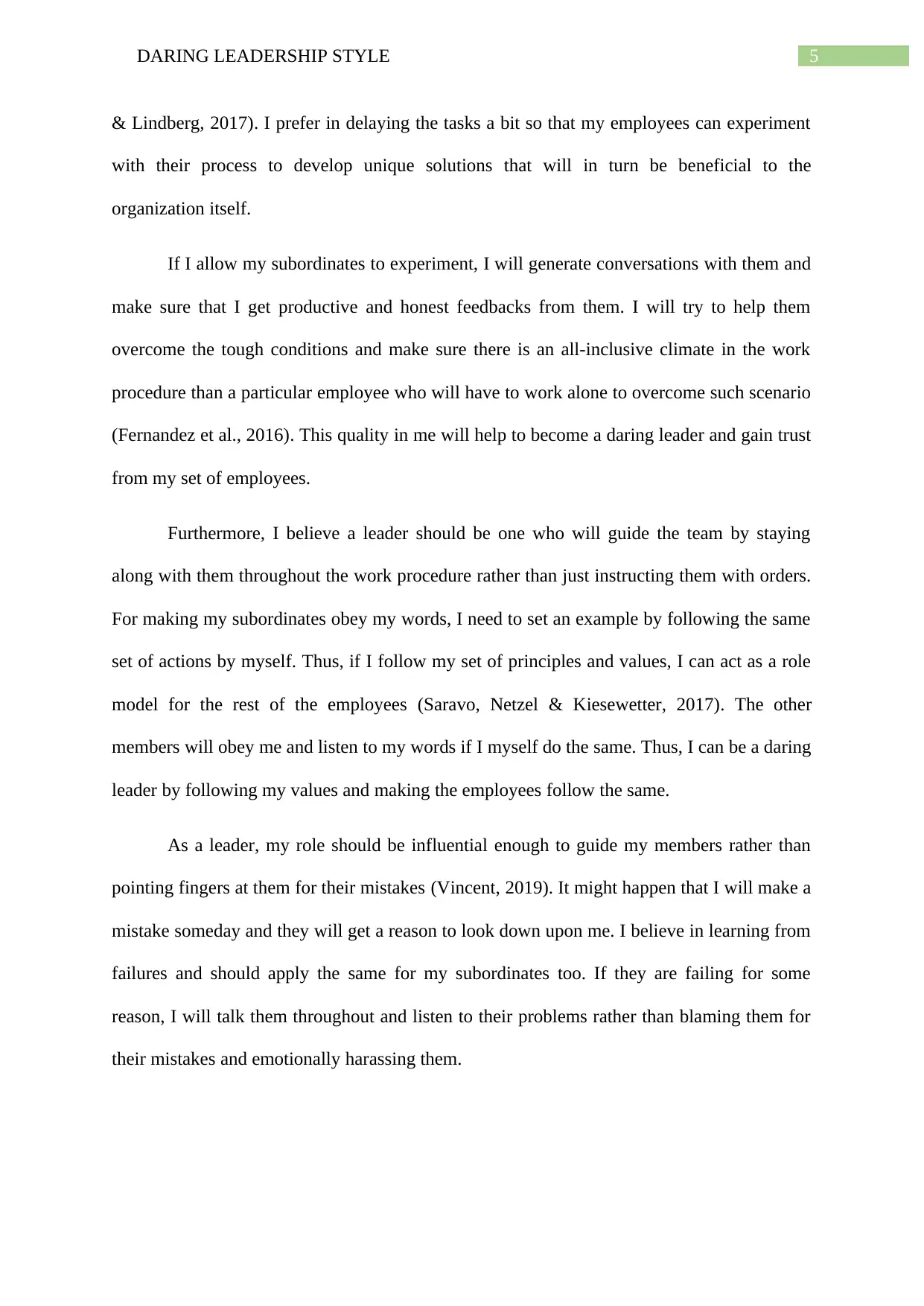
5DARING LEADERSHIP STYLE
& Lindberg, 2017). I prefer in delaying the tasks a bit so that my employees can experiment
with their process to develop unique solutions that will in turn be beneficial to the
organization itself.
If I allow my subordinates to experiment, I will generate conversations with them and
make sure that I get productive and honest feedbacks from them. I will try to help them
overcome the tough conditions and make sure there is an all-inclusive climate in the work
procedure than a particular employee who will have to work alone to overcome such scenario
(Fernandez et al., 2016). This quality in me will help to become a daring leader and gain trust
from my set of employees.
Furthermore, I believe a leader should be one who will guide the team by staying
along with them throughout the work procedure rather than just instructing them with orders.
For making my subordinates obey my words, I need to set an example by following the same
set of actions by myself. Thus, if I follow my set of principles and values, I can act as a role
model for the rest of the employees (Saravo, Netzel & Kiesewetter, 2017). The other
members will obey me and listen to my words if I myself do the same. Thus, I can be a daring
leader by following my values and making the employees follow the same.
As a leader, my role should be influential enough to guide my members rather than
pointing fingers at them for their mistakes (Vincent, 2019). It might happen that I will make a
mistake someday and they will get a reason to look down upon me. I believe in learning from
failures and should apply the same for my subordinates too. If they are failing for some
reason, I will talk them throughout and listen to their problems rather than blaming them for
their mistakes and emotionally harassing them.
& Lindberg, 2017). I prefer in delaying the tasks a bit so that my employees can experiment
with their process to develop unique solutions that will in turn be beneficial to the
organization itself.
If I allow my subordinates to experiment, I will generate conversations with them and
make sure that I get productive and honest feedbacks from them. I will try to help them
overcome the tough conditions and make sure there is an all-inclusive climate in the work
procedure than a particular employee who will have to work alone to overcome such scenario
(Fernandez et al., 2016). This quality in me will help to become a daring leader and gain trust
from my set of employees.
Furthermore, I believe a leader should be one who will guide the team by staying
along with them throughout the work procedure rather than just instructing them with orders.
For making my subordinates obey my words, I need to set an example by following the same
set of actions by myself. Thus, if I follow my set of principles and values, I can act as a role
model for the rest of the employees (Saravo, Netzel & Kiesewetter, 2017). The other
members will obey me and listen to my words if I myself do the same. Thus, I can be a daring
leader by following my values and making the employees follow the same.
As a leader, my role should be influential enough to guide my members rather than
pointing fingers at them for their mistakes (Vincent, 2019). It might happen that I will make a
mistake someday and they will get a reason to look down upon me. I believe in learning from
failures and should apply the same for my subordinates too. If they are failing for some
reason, I will talk them throughout and listen to their problems rather than blaming them for
their mistakes and emotionally harassing them.
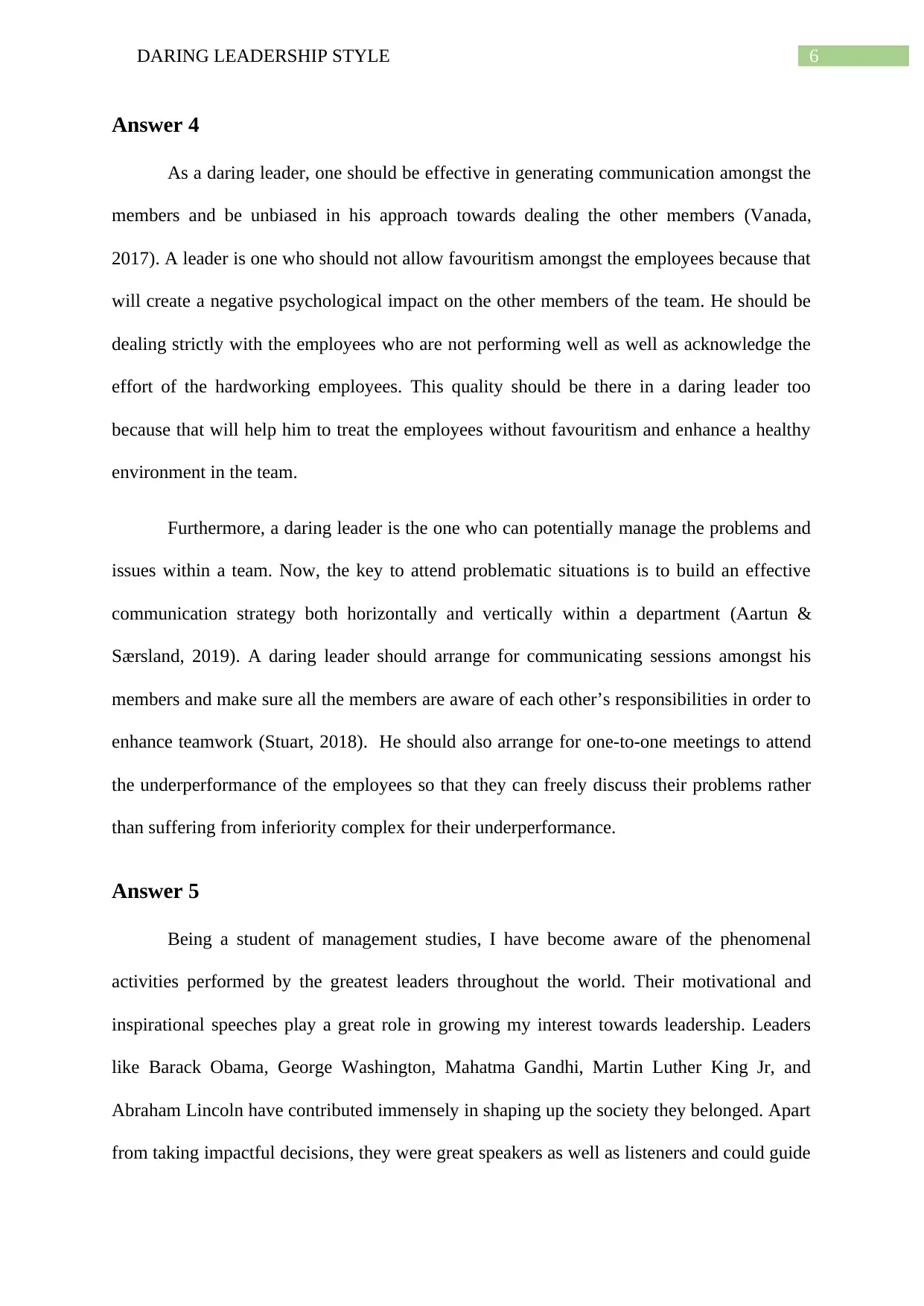
6DARING LEADERSHIP STYLE
Answer 4
As a daring leader, one should be effective in generating communication amongst the
members and be unbiased in his approach towards dealing the other members (Vanada,
2017). A leader is one who should not allow favouritism amongst the employees because that
will create a negative psychological impact on the other members of the team. He should be
dealing strictly with the employees who are not performing well as well as acknowledge the
effort of the hardworking employees. This quality should be there in a daring leader too
because that will help him to treat the employees without favouritism and enhance a healthy
environment in the team.
Furthermore, a daring leader is the one who can potentially manage the problems and
issues within a team. Now, the key to attend problematic situations is to build an effective
communication strategy both horizontally and vertically within a department (Aartun &
Særsland, 2019). A daring leader should arrange for communicating sessions amongst his
members and make sure all the members are aware of each other’s responsibilities in order to
enhance teamwork (Stuart, 2018). He should also arrange for one-to-one meetings to attend
the underperformance of the employees so that they can freely discuss their problems rather
than suffering from inferiority complex for their underperformance.
Answer 5
Being a student of management studies, I have become aware of the phenomenal
activities performed by the greatest leaders throughout the world. Their motivational and
inspirational speeches play a great role in growing my interest towards leadership. Leaders
like Barack Obama, George Washington, Mahatma Gandhi, Martin Luther King Jr, and
Abraham Lincoln have contributed immensely in shaping up the society they belonged. Apart
from taking impactful decisions, they were great speakers as well as listeners and could guide
Answer 4
As a daring leader, one should be effective in generating communication amongst the
members and be unbiased in his approach towards dealing the other members (Vanada,
2017). A leader is one who should not allow favouritism amongst the employees because that
will create a negative psychological impact on the other members of the team. He should be
dealing strictly with the employees who are not performing well as well as acknowledge the
effort of the hardworking employees. This quality should be there in a daring leader too
because that will help him to treat the employees without favouritism and enhance a healthy
environment in the team.
Furthermore, a daring leader is the one who can potentially manage the problems and
issues within a team. Now, the key to attend problematic situations is to build an effective
communication strategy both horizontally and vertically within a department (Aartun &
Særsland, 2019). A daring leader should arrange for communicating sessions amongst his
members and make sure all the members are aware of each other’s responsibilities in order to
enhance teamwork (Stuart, 2018). He should also arrange for one-to-one meetings to attend
the underperformance of the employees so that they can freely discuss their problems rather
than suffering from inferiority complex for their underperformance.
Answer 5
Being a student of management studies, I have become aware of the phenomenal
activities performed by the greatest leaders throughout the world. Their motivational and
inspirational speeches play a great role in growing my interest towards leadership. Leaders
like Barack Obama, George Washington, Mahatma Gandhi, Martin Luther King Jr, and
Abraham Lincoln have contributed immensely in shaping up the society they belonged. Apart
from taking impactful decisions, they were great speakers as well as listeners and could guide
Paraphrase This Document
Need a fresh take? Get an instant paraphrase of this document with our AI Paraphraser
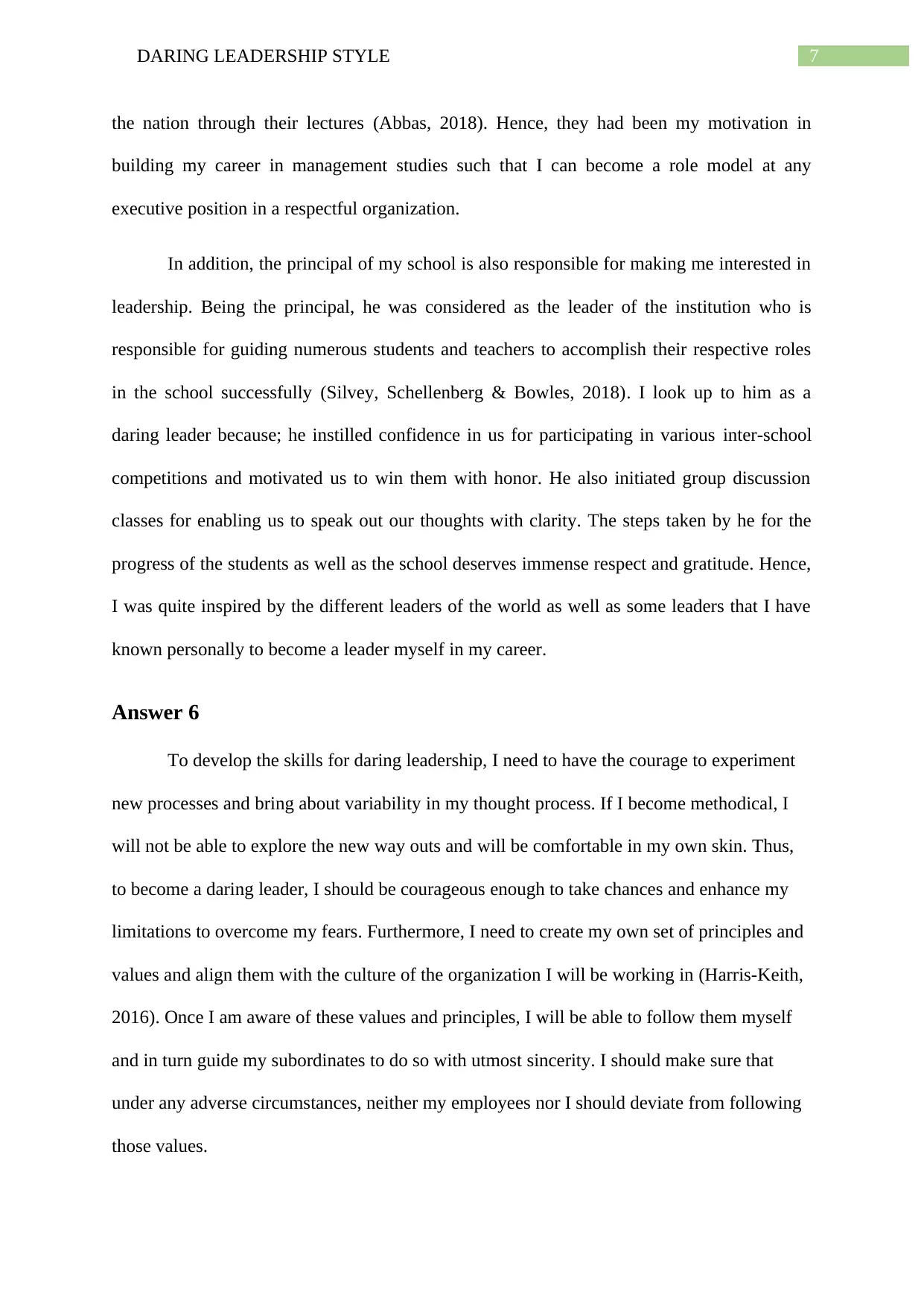
7DARING LEADERSHIP STYLE
the nation through their lectures (Abbas, 2018). Hence, they had been my motivation in
building my career in management studies such that I can become a role model at any
executive position in a respectful organization.
In addition, the principal of my school is also responsible for making me interested in
leadership. Being the principal, he was considered as the leader of the institution who is
responsible for guiding numerous students and teachers to accomplish their respective roles
in the school successfully (Silvey, Schellenberg & Bowles, 2018). I look up to him as a
daring leader because; he instilled confidence in us for participating in various inter-school
competitions and motivated us to win them with honor. He also initiated group discussion
classes for enabling us to speak out our thoughts with clarity. The steps taken by he for the
progress of the students as well as the school deserves immense respect and gratitude. Hence,
I was quite inspired by the different leaders of the world as well as some leaders that I have
known personally to become a leader myself in my career.
Answer 6
To develop the skills for daring leadership, I need to have the courage to experiment
new processes and bring about variability in my thought process. If I become methodical, I
will not be able to explore the new way outs and will be comfortable in my own skin. Thus,
to become a daring leader, I should be courageous enough to take chances and enhance my
limitations to overcome my fears. Furthermore, I need to create my own set of principles and
values and align them with the culture of the organization I will be working in (Harris-Keith,
2016). Once I am aware of these values and principles, I will be able to follow them myself
and in turn guide my subordinates to do so with utmost sincerity. I should make sure that
under any adverse circumstances, neither my employees nor I should deviate from following
those values.
the nation through their lectures (Abbas, 2018). Hence, they had been my motivation in
building my career in management studies such that I can become a role model at any
executive position in a respectful organization.
In addition, the principal of my school is also responsible for making me interested in
leadership. Being the principal, he was considered as the leader of the institution who is
responsible for guiding numerous students and teachers to accomplish their respective roles
in the school successfully (Silvey, Schellenberg & Bowles, 2018). I look up to him as a
daring leader because; he instilled confidence in us for participating in various inter-school
competitions and motivated us to win them with honor. He also initiated group discussion
classes for enabling us to speak out our thoughts with clarity. The steps taken by he for the
progress of the students as well as the school deserves immense respect and gratitude. Hence,
I was quite inspired by the different leaders of the world as well as some leaders that I have
known personally to become a leader myself in my career.
Answer 6
To develop the skills for daring leadership, I need to have the courage to experiment
new processes and bring about variability in my thought process. If I become methodical, I
will not be able to explore the new way outs and will be comfortable in my own skin. Thus,
to become a daring leader, I should be courageous enough to take chances and enhance my
limitations to overcome my fears. Furthermore, I need to create my own set of principles and
values and align them with the culture of the organization I will be working in (Harris-Keith,
2016). Once I am aware of these values and principles, I will be able to follow them myself
and in turn guide my subordinates to do so with utmost sincerity. I should make sure that
under any adverse circumstances, neither my employees nor I should deviate from following
those values.
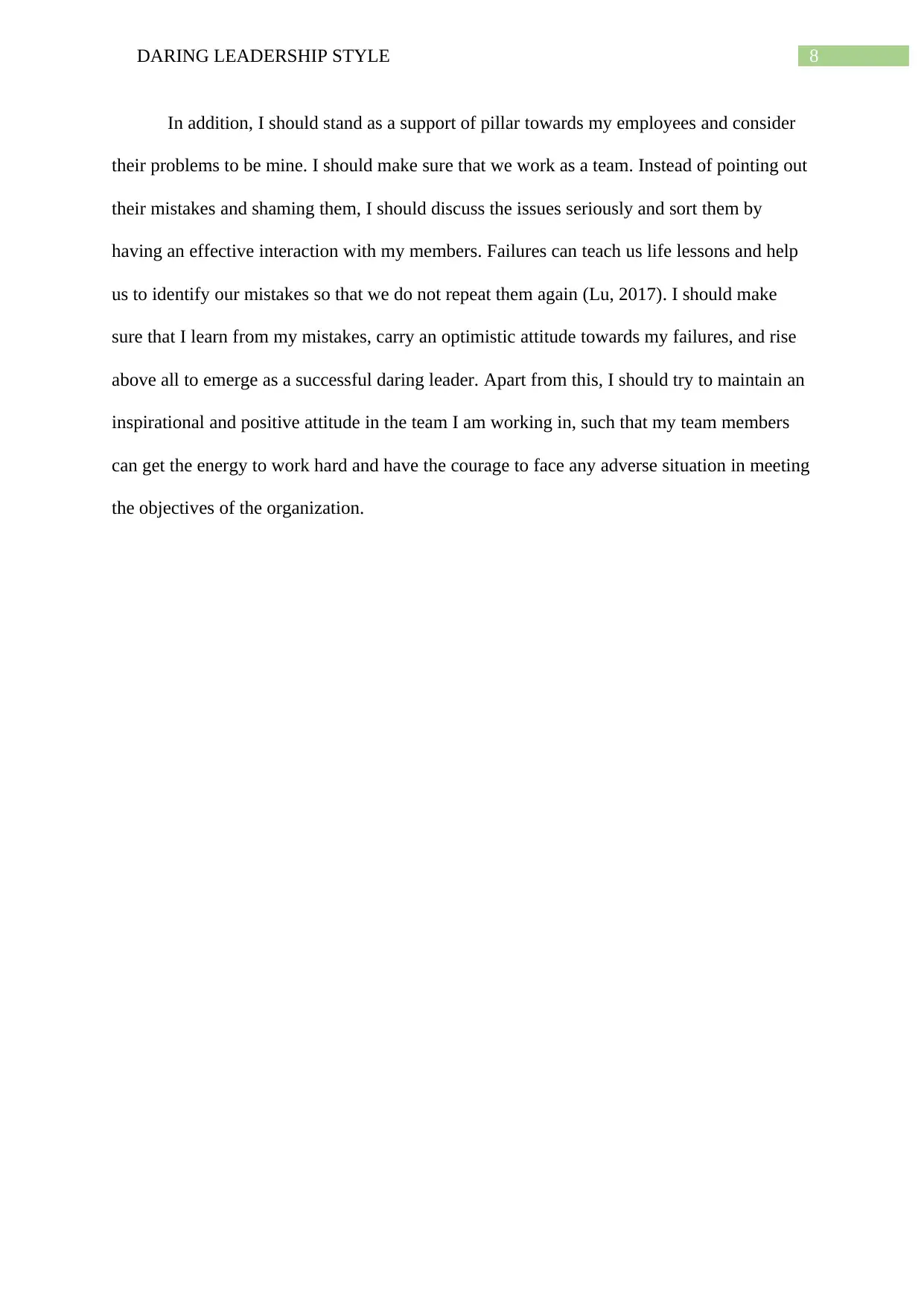
8DARING LEADERSHIP STYLE
In addition, I should stand as a support of pillar towards my employees and consider
their problems to be mine. I should make sure that we work as a team. Instead of pointing out
their mistakes and shaming them, I should discuss the issues seriously and sort them by
having an effective interaction with my members. Failures can teach us life lessons and help
us to identify our mistakes so that we do not repeat them again (Lu, 2017). I should make
sure that I learn from my mistakes, carry an optimistic attitude towards my failures, and rise
above all to emerge as a successful daring leader. Apart from this, I should try to maintain an
inspirational and positive attitude in the team I am working in, such that my team members
can get the energy to work hard and have the courage to face any adverse situation in meeting
the objectives of the organization.
In addition, I should stand as a support of pillar towards my employees and consider
their problems to be mine. I should make sure that we work as a team. Instead of pointing out
their mistakes and shaming them, I should discuss the issues seriously and sort them by
having an effective interaction with my members. Failures can teach us life lessons and help
us to identify our mistakes so that we do not repeat them again (Lu, 2017). I should make
sure that I learn from my mistakes, carry an optimistic attitude towards my failures, and rise
above all to emerge as a successful daring leader. Apart from this, I should try to maintain an
inspirational and positive attitude in the team I am working in, such that my team members
can get the energy to work hard and have the courage to face any adverse situation in meeting
the objectives of the organization.
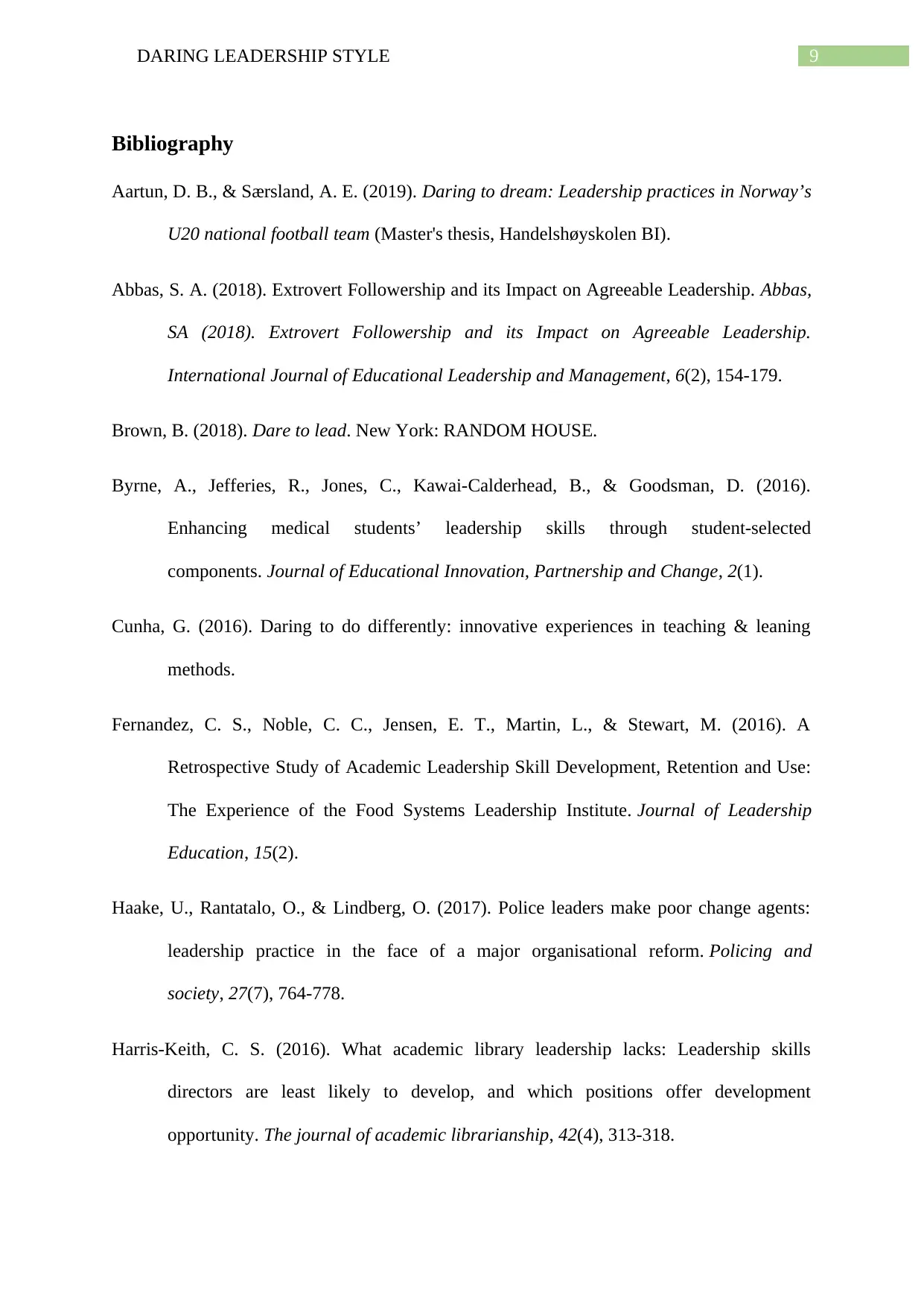
9DARING LEADERSHIP STYLE
Bibliography
Aartun, D. B., & Særsland, A. E. (2019). Daring to dream: Leadership practices in Norway’s
U20 national football team (Master's thesis, Handelshøyskolen BI).
Abbas, S. A. (2018). Extrovert Followership and its Impact on Agreeable Leadership. Abbas,
SA (2018). Extrovert Followership and its Impact on Agreeable Leadership.
International Journal of Educational Leadership and Management, 6(2), 154-179.
Brown, B. (2018). Dare to lead. New York: RANDOM HOUSE.
Byrne, A., Jefferies, R., Jones, C., Kawai-Calderhead, B., & Goodsman, D. (2016).
Enhancing medical students’ leadership skills through student-selected
components. Journal of Educational Innovation, Partnership and Change, 2(1).
Cunha, G. (2016). Daring to do differently: innovative experiences in teaching & leaning
methods.
Fernandez, C. S., Noble, C. C., Jensen, E. T., Martin, L., & Stewart, M. (2016). A
Retrospective Study of Academic Leadership Skill Development, Retention and Use:
The Experience of the Food Systems Leadership Institute. Journal of Leadership
Education, 15(2).
Haake, U., Rantatalo, O., & Lindberg, O. (2017). Police leaders make poor change agents:
leadership practice in the face of a major organisational reform. Policing and
society, 27(7), 764-778.
Harris-Keith, C. S. (2016). What academic library leadership lacks: Leadership skills
directors are least likely to develop, and which positions offer development
opportunity. The journal of academic librarianship, 42(4), 313-318.
Bibliography
Aartun, D. B., & Særsland, A. E. (2019). Daring to dream: Leadership practices in Norway’s
U20 national football team (Master's thesis, Handelshøyskolen BI).
Abbas, S. A. (2018). Extrovert Followership and its Impact on Agreeable Leadership. Abbas,
SA (2018). Extrovert Followership and its Impact on Agreeable Leadership.
International Journal of Educational Leadership and Management, 6(2), 154-179.
Brown, B. (2018). Dare to lead. New York: RANDOM HOUSE.
Byrne, A., Jefferies, R., Jones, C., Kawai-Calderhead, B., & Goodsman, D. (2016).
Enhancing medical students’ leadership skills through student-selected
components. Journal of Educational Innovation, Partnership and Change, 2(1).
Cunha, G. (2016). Daring to do differently: innovative experiences in teaching & leaning
methods.
Fernandez, C. S., Noble, C. C., Jensen, E. T., Martin, L., & Stewart, M. (2016). A
Retrospective Study of Academic Leadership Skill Development, Retention and Use:
The Experience of the Food Systems Leadership Institute. Journal of Leadership
Education, 15(2).
Haake, U., Rantatalo, O., & Lindberg, O. (2017). Police leaders make poor change agents:
leadership practice in the face of a major organisational reform. Policing and
society, 27(7), 764-778.
Harris-Keith, C. S. (2016). What academic library leadership lacks: Leadership skills
directors are least likely to develop, and which positions offer development
opportunity. The journal of academic librarianship, 42(4), 313-318.
Secure Best Marks with AI Grader
Need help grading? Try our AI Grader for instant feedback on your assignments.
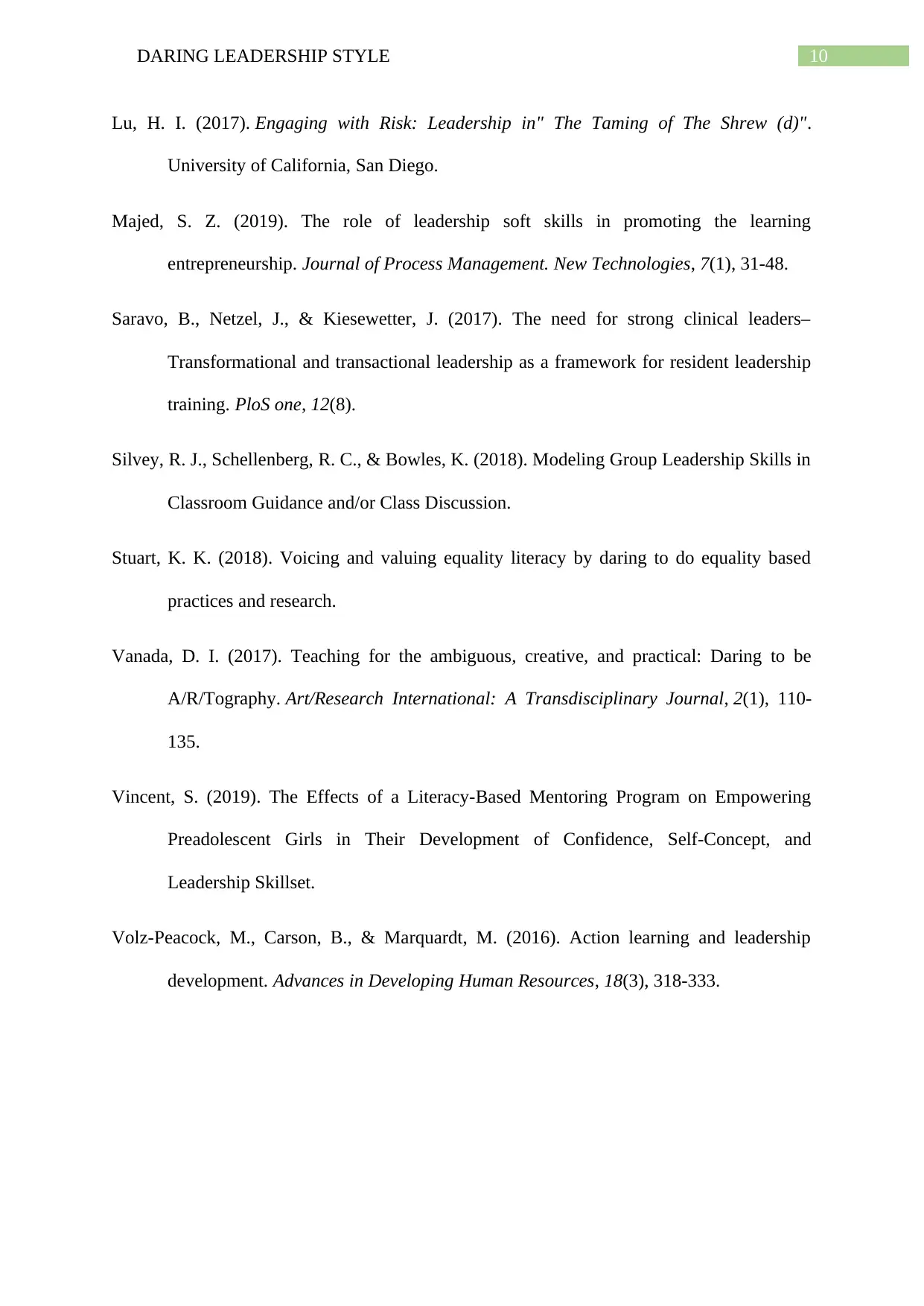
10DARING LEADERSHIP STYLE
Lu, H. I. (2017). Engaging with Risk: Leadership in" The Taming of The Shrew (d)".
University of California, San Diego.
Majed, S. Z. (2019). The role of leadership soft skills in promoting the learning
entrepreneurship. Journal of Process Management. New Technologies, 7(1), 31-48.
Saravo, B., Netzel, J., & Kiesewetter, J. (2017). The need for strong clinical leaders–
Transformational and transactional leadership as a framework for resident leadership
training. PloS one, 12(8).
Silvey, R. J., Schellenberg, R. C., & Bowles, K. (2018). Modeling Group Leadership Skills in
Classroom Guidance and/or Class Discussion.
Stuart, K. K. (2018). Voicing and valuing equality literacy by daring to do equality based
practices and research.
Vanada, D. I. (2017). Teaching for the ambiguous, creative, and practical: Daring to be
A/R/Tography. Art/Research International: A Transdisciplinary Journal, 2(1), 110-
135.
Vincent, S. (2019). The Effects of a Literacy-Based Mentoring Program on Empowering
Preadolescent Girls in Their Development of Confidence, Self-Concept, and
Leadership Skillset.
Volz-Peacock, M., Carson, B., & Marquardt, M. (2016). Action learning and leadership
development. Advances in Developing Human Resources, 18(3), 318-333.
Lu, H. I. (2017). Engaging with Risk: Leadership in" The Taming of The Shrew (d)".
University of California, San Diego.
Majed, S. Z. (2019). The role of leadership soft skills in promoting the learning
entrepreneurship. Journal of Process Management. New Technologies, 7(1), 31-48.
Saravo, B., Netzel, J., & Kiesewetter, J. (2017). The need for strong clinical leaders–
Transformational and transactional leadership as a framework for resident leadership
training. PloS one, 12(8).
Silvey, R. J., Schellenberg, R. C., & Bowles, K. (2018). Modeling Group Leadership Skills in
Classroom Guidance and/or Class Discussion.
Stuart, K. K. (2018). Voicing and valuing equality literacy by daring to do equality based
practices and research.
Vanada, D. I. (2017). Teaching for the ambiguous, creative, and practical: Daring to be
A/R/Tography. Art/Research International: A Transdisciplinary Journal, 2(1), 110-
135.
Vincent, S. (2019). The Effects of a Literacy-Based Mentoring Program on Empowering
Preadolescent Girls in Their Development of Confidence, Self-Concept, and
Leadership Skillset.
Volz-Peacock, M., Carson, B., & Marquardt, M. (2016). Action learning and leadership
development. Advances in Developing Human Resources, 18(3), 318-333.
1 out of 11
Related Documents
Your All-in-One AI-Powered Toolkit for Academic Success.
+13062052269
info@desklib.com
Available 24*7 on WhatsApp / Email
![[object Object]](/_next/static/media/star-bottom.7253800d.svg)
Unlock your academic potential
© 2024 | Zucol Services PVT LTD | All rights reserved.





